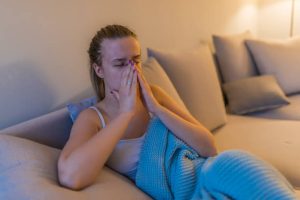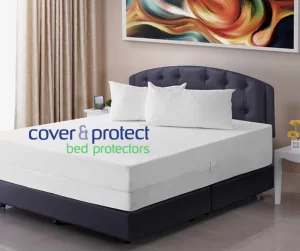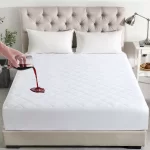The Comprehensive Guide to Protecting Your Bedding for Asthma and Allergy Sufferers 101

If you suffer from asthma or allergies, your bedroom can quickly become an overlooked source of discomfort. Your bedding, in particular, plays a crucial role in either exacerbating or alleviating symptoms. With proper bedding protection, you can transform your sleeping environment into a haven of comfort and health. This comprehensive guide will walk you through how to protect your bedding effectively, highlighting solutions like Cover and Protect Bedding Protection to help you breathe easier and sleep better.
Click here to Cover and Protect Bedding Protectors Website for sales and further information:
Understanding the Link Between Bedding, Asthma, and Allergies
Asthma and allergies are often triggered by environmental factors, many of which are prevalent in your bedroom. Common culprits include dust mites, pet dander, mold, and pollen—all of which can accumulate in your bedding. Without adequate protection, these allergens can become deeply embedded in your mattress, pillows, and blankets, triggering night time symptoms such as coughing, sneezing, and wheezing.
Click to read information on Asthma & Allergies
The Role of Dust Mites
Dust mites are microscopic creatures that thrive in warm, humid environments. They feed on dead skin cells and are a significant source of allergens. Their waste products and body parts can provoke allergic reactions, making them a common trigger for asthma and allergy sufferers.
click for information on dust mites
Mold and Mildew
Mold and mildew flourish in damp conditions, such as a poorly ventilated bedroom or bedding that retains moisture. Their spores can irritate the respiratory system and worsen asthma and allergy symptoms.
Pet Dander and Pollen
Even if your pets don’t sleep in your bed, their dander can find its way into your bedding. Additionally, pollen can cling to your clothing and hair, transferring to your sheets and pillowcases.
Key Features to Look for in Bedding Protection

When selecting bedding protection, it’s essential to choose products designed specifically for asthma and allergy sufferers. Cover and Protect Bedding Protection offers a range of solutions that address these needs.
Click here to Cover and Protect Bedding Protectors Website for sales and further information:
Here are the key features to consider:
Hypoallergenic Materials
Hypoallergenic bedding is designed to reduce allergen exposure. Look for covers and sheets made from tightly woven fabrics that block dust mites, pet dander, and other allergens.
Waterproof Layers
A waterproof layer is critical for protecting your mattress and pillows from spills, sweat, and other moisture that can lead to mold and mildew growth. Waterproof bedding also helps to extend the life of your mattress.
Breathability
Breathable materials are essential for comfort, especially if you’re prone to night sweats. Products like those from Cover and Protect Bedding Protection combine breathability with allergen resistance, ensuring you stay cool and comfortable.
Easy Maintenance
Choose bedding that’s machine washable and durable enough to withstand frequent washing. Regular cleaning is vital for removing allergens and maintaining a healthy sleeping environment.
How to Protect Each Element of Your Bedding
Protecting your bedding involves more than just covering your mattress. Here’s how to safeguard each component effectively:
Mattress Protection
Your mattress is a significant investment and a primary target for allergens. A high-quality mattress protector acts as a barrier against dust mites, spills, and other irritants. Cover and Protect Bedding Protection offers mattress encasements with zippered closures to seal your mattress completely, preventing allergen infiltration.
Click to Cover and Protect website for all your bedding protection products:
Pillow Protection
Pillows can harbor dust mites, mold, and bacteria. Use pillow protectors made from hypoallergenic and waterproof materials to shield your pillows. Wash both the protectors and pillowcases regularly to keep allergens at bay.
Duvet and Blanket Protection
Your duvet and blankets can also trap allergens. Consider using duvet covers that are specifically designed for allergy sufferers. These covers are easy to remove and wash, ensuring a cleaner sleep environment.
Sheets and Linens
Opt for tightly woven, hypoallergenic sheets that minimize allergen penetration. Wash your sheets and pillowcases weekly in hot water to kill dust mites and remove allergens.
Additional Tips for an Allergy-Free Bedroom
Regular Cleaning
Vacuum your bedroom carpet and rugs weekly using a vacuum with a HEPA filter. Dust surfaces with a damp cloth to capture allergens rather than spreading them into the air.
Control Humidity:
Maintain indoor humidity levels between 30% and 50% to discourage dust mites and mold growth. Use a dehumidifier if necessary.
Air Purification:
Invest in an air purifier with a HEPA filter to remove airborne allergens from your bedroom.
Pet Management:
If you have pets, keep them out of your bedroom and wash their bedding frequently. Groom your pets regularly to reduce dander.
Seasonal Considerations:
During allergy seasons, take extra precautions such as showering before bed to remove pollen and keeping windows closed to minimize allergen entry.
Why Choose Cover and Protect Bedding Protection?
Cover and Protect Bedding Protection specializes in providing innovative solutions for asthma and allergy sufferers. Here’s why their products stand out:
Proven Effectiveness:
The company’s bedding protectors are scientifically tested to block allergens, ensuring a healthier sleep environment.
Premium Materials:
Each product is crafted from high-quality, durable materials that combine comfort with functionality.
Comprehensive Range:
From mattress protectors to pillow encasements, Cover and Protect Bedding Protection offers everything you need to safeguard your bedding.
Trusted Brand:
With a reputation for excellence, Cover and Protect Bedding Protection is a trusted choice for families seeking reliable allergy and asthma solutions.
How to Incorporate Bedding Protection into Your Routine
Initial Setup:
Start by covering your mattress, pillows, and duvets with protective encasements. Wash all your bedding, including the protectors, before use to eliminate manufacturing residues.
Regular Maintenance:
Wash your bedding and protectors weekly in hot water (at least 60°C).
Vacuum your mattress protector monthly to remove surface debris.
Replace your protectors every few years or as recommended by the manufacturer.
Monitoring Effectiveness:
Pay attention to your symptoms. If you notice improvements, it’s a sign that your bedding protection strategy is working. If not, consider additional measures such as upgrading your air purifier or consulting an allergist.
Conclusion
Creating an allergy-free bedroom is essential for asthma and allergy sufferers, and protecting your bedding is a significant first step. By investing in high-quality products like those from Cover and Protect Bedding Protection, you can reduce allergen exposure, alleviate symptoms, and enjoy a better night’s sleep. With proper care and maintenance, your bedding can become a sanctuary of comfort and health, helping you breathe easier and wake up refreshed every day.
Transform your sleeping environment today with Cover and Protect Bedding Protection and experience the difference in your health and well-being.




